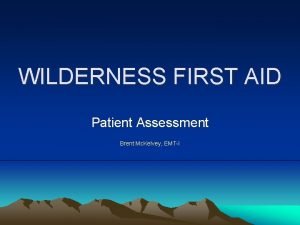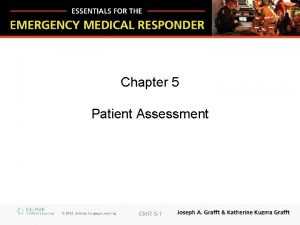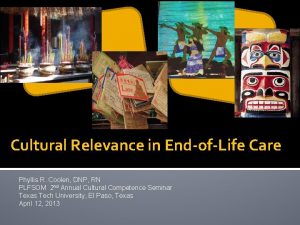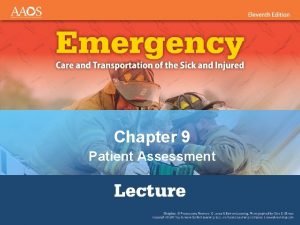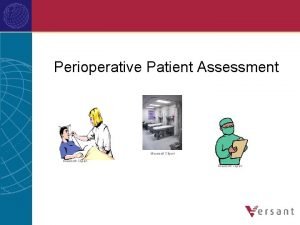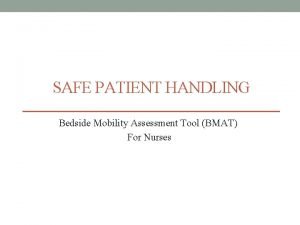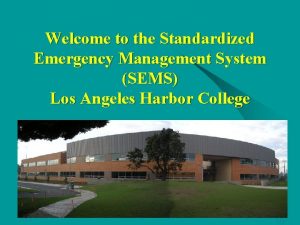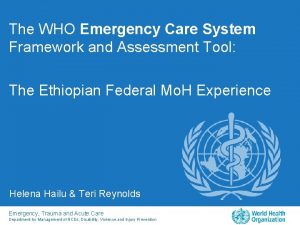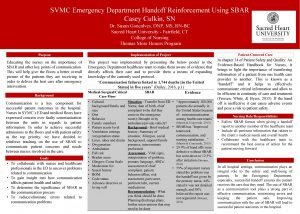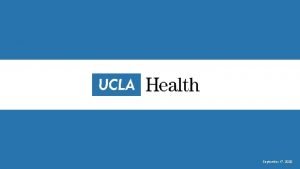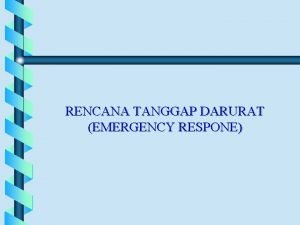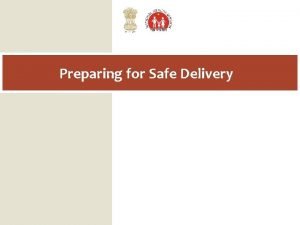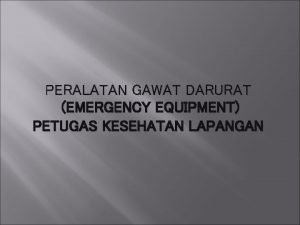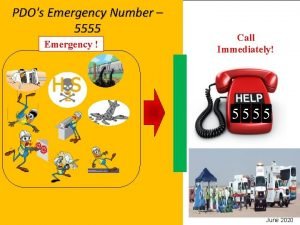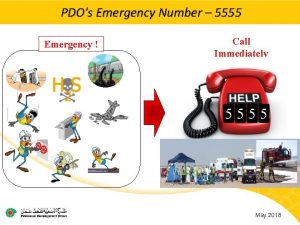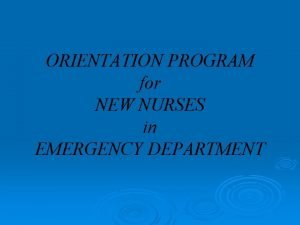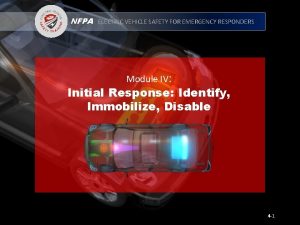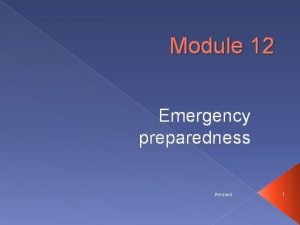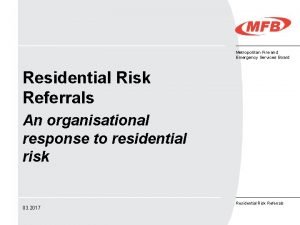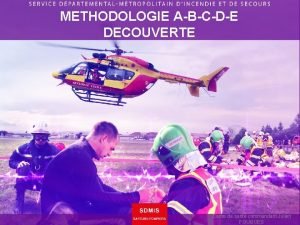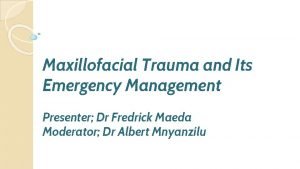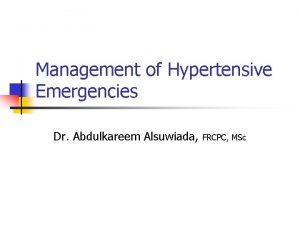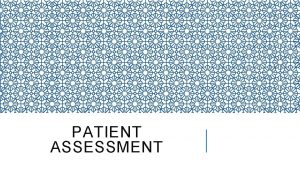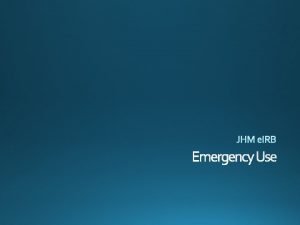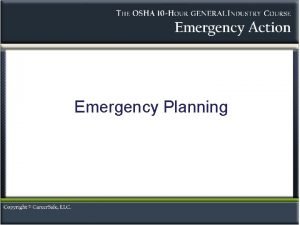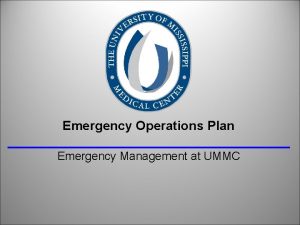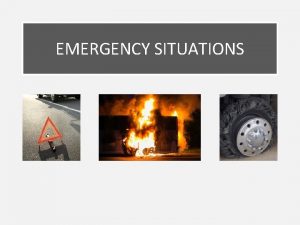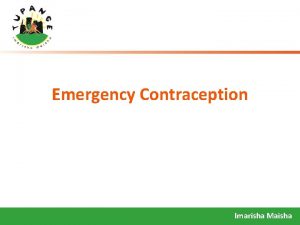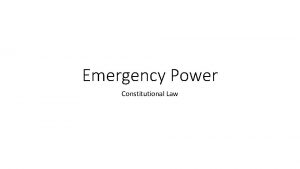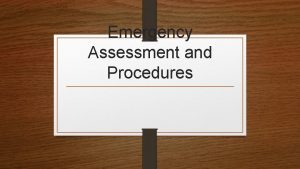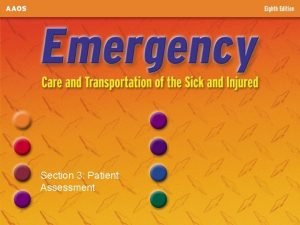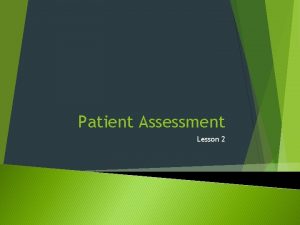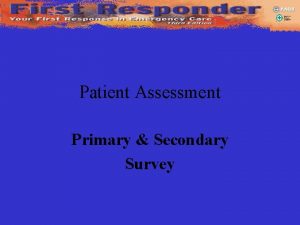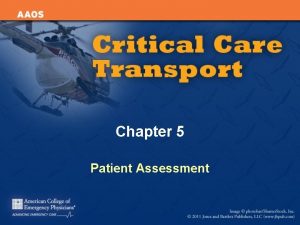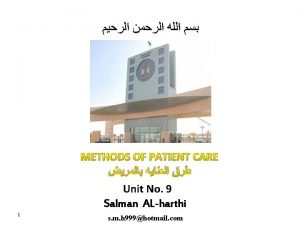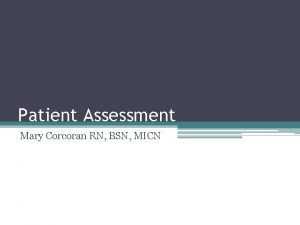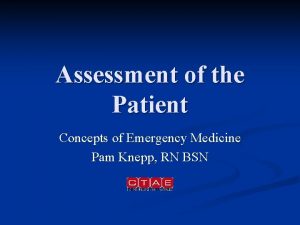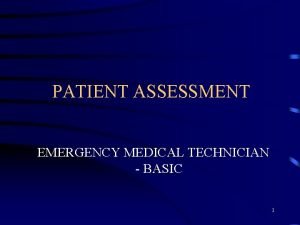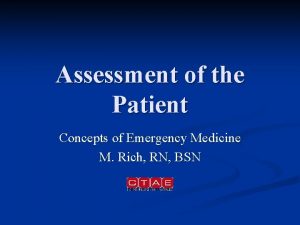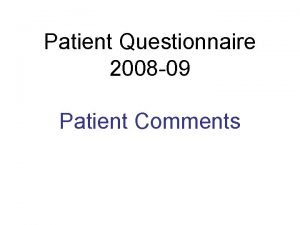PATIENT ASSESSMENT PATIENT ASSESSMENT Patient assessment in emergency




























- Slides: 28

PATIENT ASSESSMENT

PATIENT ASSESSMENT Patient assessment in emergency medicine as performed by First Responders & EMS providers consists of 7 parts: 1. ____________________ 2. ____________ (6 components) 3. Focused _____ and physical _____ 4. ____________________ 5. ____________________ 6. ____________________ 7. _____________________

ØFollow BSI (______________ ___) precautions as needed, minimum standard requires gloves ØEvaluate the _____ of the scene but additional ______ should be worn as the situation requires SCENE EVALUATION

SCENE EVALUATION ØDetermine mechanism of injury for a ___________ victim or nature of illness for a _____________ victim. ØMechanism of injury=___________________________

SCENE EVALUATION ØNature of illness=____________________________

SCENE EVALUATION ØNumber of _______

INITIAL ASSESSMENT ØDone to detect & immediately correct any life-threatening problems of the __________________ ØCorrections of life-threatening problems are essential to survival ØThere are 6 components of the initial assessment: form a general impression, determine level of responsiveness, assess the airway, assess breathing, assess circulation, assess priority

1. GENERAL IMPRESSION o. Make a general impression of pt’s surroundings & condition o. If mechanism of injury suggests an injury to the spine, apply _________________________of the neck to protect the spine and prevent further movement

2. LEVEL OF RESPONSIVENESS o. Assess pt’s responsiveness, level of distress, facial expressions, age, ability to _______, ______________ o. If pt appears unresponsive, tap their shoulder and ask “Are you ok? ”

3. ASSESS THE AIRWAY o. Is the pt’s airway ________? o. If the pt is awake, alert, and talking to you, the airway is open, the pt is breathing and has a pulse o. If the pt is unresponsive, open the airway using _____________________________

4. ASSESS BREATHING o. Is the pt breathing adequately? o. If there is no breathing, prepare to provide _______________ o. If there is inadequate breathing, the pt may need oxygen or breathing assistance using a _________________ ___

5. ASSESS CIRCULATION o. Does the pt have a __________? o. Do you see any serious external bleeding? o. What is the pt’s skin _________? o. If there is no pulse or signs of impaired circulation, start _____________________________ ___ o. Apply ________________ to any serious bleeding

6. ASSESS PRIORITY o. Determine the ___________ and _______________ of the pt’s condition o. Seek immediate and appropriate transport to a medical facility

FOCUSED HISTORY & PHYSICAL EXAM ØAfter initial assessment has been done & any life-threatening problems treated, continue on to the focused history & physical exam ØIn _____ seconds check head, eyes, neck, chest, abdomen, pelvis, arms, legs and back ØTake a set of _____ & assess the skin ____________________ ØTake _______ history, if time permits

FOCUSED HISTORY & PHYSICAL EXAM During the 90 second assessment, assess for the following: 1. _______=look & feel for deformities, bruises, open wounds, tenderness, depressions, & swelling. Check the ears & nose for blood & _______. Check the mouth for bleeding, loose teeth, or foreign bodies 2. _______=check for same size _________

FOCUSED HISTORY & PHYSICAL EXAM 3. _______=look & feel for deformities, bruises, depressions, open wounds, tenderness, & swelling. Check for a ________________necklace/bracelet

FOCUSED HISTORY & PHYSICAL EXAM 4. ______=look & feel for deformities, bruises, open wounds, tenderness, depressions, & swelling 5. ___________=look & feel for deformities, bruises, open wounds, tenderness, depressions, & swelling

FOCUSED HISTORY & PHYSICAL EXAM 6. __________=look & feel for deformities, bruises, open wounds, tenderness, depressions, & swelling. Gently press ______________ ___ on the pelvis for pain. Gently grab the upper thighs & press inward for __________.

FOCUSED HISTORY & PHYSICAL EXAM 7. _________=look & feel for deformities, bruises, open wounds, tenderness, depressions, & swelling. If possible check for movement & sensation by having pt wiggle fingers, touch a finger & have them identify which finger was touched

FOCUSED HISTORY & PHYSICAL EXAM 8. _______=look & feel for deformities, bruises, open wounds, tenderness, depressions, & swelling. If possible check for movement & sensation. 9. ________=slide your hand under back as far as it will go without moving the pt to feel for any deformities, open wounds, tenderness, depressions, or swelling

FOCUSED HISTORY & PHYSICAL EXAM Obtain SAMPLE history if time permits: ØS _________________(What is wrong? ) ØA __________ (Are you allergic to any medications? ) ØM ___________ (What medications are you taking? ) ØP _________________________ (What other medical problems do you have? ) ØL _________________________ (When was the last time you ate/drank? ) ØE

DETAILED ASSESSMENT ØDone to identify further ________ or illness ØIncludes careful and systemic _________ and _________ for signs of injury and illness ØDone when ______________ such as in the back of the ambulance once en route to the hospital

ONGOING ASSESSMENT ØNo assessment is ever ___________ ØWhen taking care of an injured/ill patient, always ________________ the initial assessment, vital signs, and history ØContinuously note any _______

COMMUNICATIONS ØObtain the patient’s first and last name ØAddress patients by their ______________ unless permission has been given by the patient to use the first name ØNever call patients ________________ or use the terms honey, sweetie, gramps, sugar, or partner ØBe considerate and respectful – care for the patient like you want to be cared for ØBe aware of your _________________ and position

COMMUNICATIONS ØIf possible position yourself _________________ the eye level of the patient, it is less intimidating ØUse ____________to let your patient know you are interested and attentive to their needs ØBe ____________ – attempt to answer patient’s questions honestly without scaring them. Let them know you are

COMMUNICATIONS ØKeep the patient/family ___________ - Keep them informed of any procedures you are doing. If you are going to cause pain, let everyone know but tell them you will be as gentle as possible Ø_____________ – to the patient and family members, don’t interrupt unless necessary

COMMUNICATIONS ØCommunication happens between the ____________ & the ___________ (and their family) ØCommunication also happens between the ___________ & ______________ via radio/cell phone report and also a verbal report (hand-off) to the hospital staff

DOCUMENTATION Written report that describes: 1. Physical findings of an exam 2. ____________ performed 3. _______________ given 4. _______________ 5. Name, age, and address of the client
 Emergency move vs rapid extrication
Emergency move vs rapid extrication Patient 2 patient
Patient 2 patient Wilderness first aid patient assessment form
Wilderness first aid patient assessment form Emr patient assessment
Emr patient assessment Kleinman and campbell patient explanatory assessment model
Kleinman and campbell patient explanatory assessment model Secondary assessment
Secondary assessment Chapter 9 patient assessment worksheet answers
Chapter 9 patient assessment worksheet answers Patient assessment clipart
Patient assessment clipart Bmat level 4
Bmat level 4 Assessment of patient
Assessment of patient Middle level of sems
Middle level of sems Who emergency care system framework
Who emergency care system framework Svmc emergency room
Svmc emergency room Nethercutt trauma center
Nethercutt trauma center Pengertian shalat qashar
Pengertian shalat qashar Purchasing purchasing
Purchasing purchasing Mva tray in labour room
Mva tray in labour room Prehospital emergency care 10th edition
Prehospital emergency care 10th edition Pre-hospital communication
Pre-hospital communication Emergency equipment adalah
Emergency equipment adalah Pdo emergency number
Pdo emergency number Pdo emergency number
Pdo emergency number Emergency department nursing orientation manual
Emergency department nursing orientation manual Nfpa electric vehicle emergency field guide
Nfpa electric vehicle emergency field guide Module 12 emergency procedures
Module 12 emergency procedures Metropolitan fire and emergency services board
Metropolitan fire and emergency services board Sample opqrst
Sample opqrst Emergency management of maxillofacial trauma
Emergency management of maxillofacial trauma Htn emergency vs urgency
Htn emergency vs urgency


